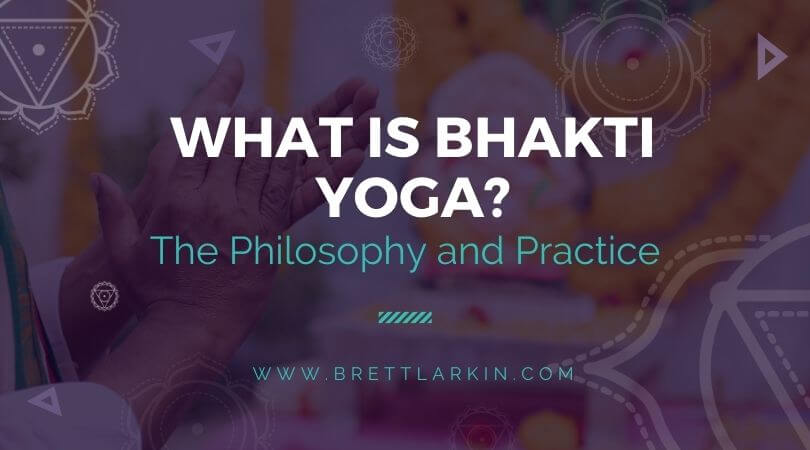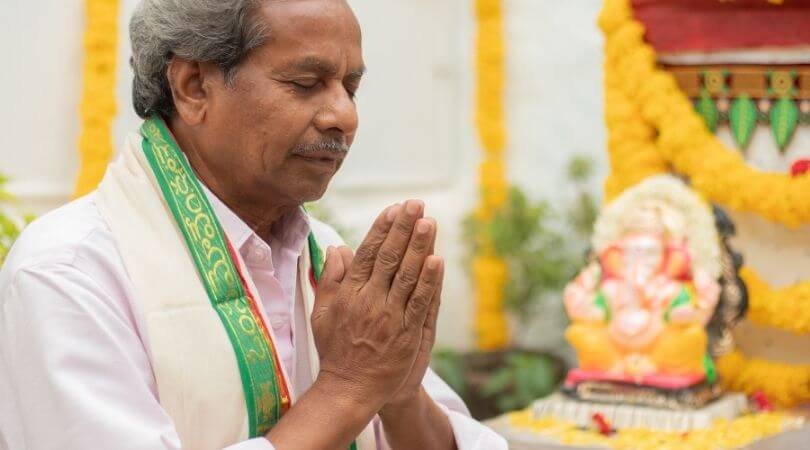
In short, Bhakti is the yoga of love and devotion.
Sounds nice, right!
So what does that mean exactly?
Recall that the word yoga comes from the Sanskrit root yuj meaning to yoke, join, or unite. The union being referred to is the union of the self with god, which is the purpose of yoga.
So we do the PRACTICES of yoga to prepare for and eventually reach the STATE of yoga (also called god realization, samadhi, oneness with pure consciousness, and more).
What the yoga practice looks like depends on the tradition, but all paths of yoga are just different roads to this same destination.
And so in the bhakti yoga tradition, practitioners achieve the state of yoga through intense love and devotion to god.
Bhakti yoga is one of the traditional yoga systems mentioned in the sacred text the Bhagavad Gita. While this text was written around the 2nd century BCE, the bhakti movement began to emerge from Hinduism and spread in India in the 7th century CE.
What is considered a traditional yoga system varies based on the source. Some sources include raja yoga (the yoga of the mind) and kriya yoga (the yoga of the energy body) for example, while the Bhagavad Gita outlines the three primary yoga systems as:
- Karma yoga – The yoga of action
- Jnana yoga – The yoga of knowledge
- Bhakti yoga – The yoga of devotion
In the Bhagavad Gita, Lord Krishna says of all these paths of yoga, Bhakti is supreme as it is the most direct path to god.
Aside from the Bhagavad Gita, if not superior, bhakti is thought to be at least an essential part of every spiritual path. An intense devotion to source is considered the key to maintaining the energy, inspiration, and non-egoism needed in order to succeed on the path of self-love, self realization, and ultimately god realization.
What does Bhakti mean?
The word bhakti is most often translated as “devotion” and here it specifically means devotion to god.
Remember that while the teachings of yoga are spiritual, the yogic concept of god is more generalized and open which makes yoga compatible with religion.
But if you’re not into religion or the term “god”, you can of course still practice yoga and bhakti yoga and swap the word god with your intuitive understanding of divinity (and totally swap that out for the word “god” throughout this article too!)
The bhakti yoga practice is cultivating intense love for whatever form of divinity you resonate with, whether it’s a personal god (related to as a person) or more of a formless force. So energy, pure love, source, the great mystery, Absolute Truth, the supreme soul, Brahman, the Christian God, a hindu deity—use what suits you!
Bhakti yoga, like yoga itself, is considered to be both the means and the end of the practice, meaning essentially we PRACTICE bhakti (lower) in order to reach the STATE of bhakti (higher).

Lower Bhakti (Apara-Bhakti)
Apara-bhakti is the spiritual practice of using external aids and rituals to express one’s devotion to god that is honored as a separate entity from the self.
These practices help the bhakti yogi (bhakta) purify their thoughts and channel their powerful emotions away from negativity and towards love for and devotion to god.
The eventual complete surrender of the lower self to the higher self is thought to be the final opening needed to receive the blessing of higher bhakti.
Higher Bhakti (Para-Bhakti)
It is believed that higher bhakti will arise naturally in time with the practice of lower bhakti and that this state frees the bhakta from suffering.
In this state, the ego cannot assert itself so there is no longer a sense of god being separate from the self. In this sense, para-bhakti is similar to samadhi, or the union with the divine, that is the aim of all paths of yoga.
In para-bhakti, the devotee no longer needs external devotional rituals as their heart is saturated with divine love, all things are seen as god, and all daily acts inherently become service to god.
How to Practice Bhakti in the Modern World
You might be thinking, okay, great! So what does a bhakti yoga practice actually look like? Does it involve asana practice? Does my yoga teacher offer it at my studio? Read on, friends, and I’ll share some common forms of apara-bhakti so you can try it for yourself!

Chanting
Bhaktas chant and use their voices as an offering of love for god and this devotional act opens the heart to the experience of supreme love. Bhakti yogis might attend a kirtan and chant mantras or the names of deities, sing at church, or sing their favorite spiritual songs at home as an offering to the divine. It’s not necessary to have a good voice to practice this form of bhakti as it’s all about the intention one holds in their heart.
Chanting is the practice most commonly associated with bhakti yoga, but bhakti community members emphasize that it’s not the only way to practice bhakti yoga. So if you’re not into kirtan, singing, or chanting, there are still plenty of ways to practice the yoga of devotion.
Japa Meditation
Japa is a mantra meditation using the repetition of a word or short phrase that focuses the mind on god and replaces negative thoughts and feelings with joy and love. Bhaktas use mantras given by their teachers or ones they feel drawn to and often practice daily. They might use a mala to count 108 mantra recitations, set a timer, or recite internally or with a quiet voice throughout the day.

Visualization Meditation
Bhaktas may also meditate using their personal image of god (ishta devata) as the object of meditation. Training the mind on a personal form of divinity while feeling into the heart center cultivates closeness with the divine.
Contemplation
Students of the bhakti tradition also engage the mind in contemplation to hone their discernment between the eternal and the temporary. Bhakti yoga practitioners might read sacred texts like the Bhagavad Gita or the Bhakti Sutras, or listen to inspiring divine stories to maintain a spiritually rooted perspective on life.
Prayer
Bhakti yogis pray not for material things, but with genuine gratitude and humility asking mostly to come home to the divine. A bhakti yogi might pray at the end of meditation practice or a few times throughout the day and ask for greater heart opening and connection to the source.
Puja
Puja means “act of worship” and is a ceremonial offering to the source found in many traditions including Hinduism, Buddhism, Vedism (meaning “relating to the Veda” or the Vedic texts), and more. Anyone can use pujas to strengthen their connection with god by offering food, light, water, flowers, etc. to an image of the divine on an altar or out in nature.

Devotional Service
Relationships can become apara-bhakti practices as bhaktas practice seeing god in everyone and thus by serving others they devote themselves to god while creating positive change in the world. Helping people when asked, before asked, and volunteering to do the things others don’t want to do with the intention of serving the divine are simple ways to walk the path of devotion. One might also channel their love for god into their relationship with the planet and act in service of the environment.
Spending Time in Nature
Some say that to become a devotee, we need only to experience the splendor of nature or contemplate the cosmos. As we sense our smallness in the world and the universe we cannot help but reconnect with something larger than ourselves. A devotee might spend time simply being in nature or gazing at the stars and sensing the presence of the divine in the miraculousness of all things.
Practicing Gratitude
Expressing heartfelt gratitude internally or externally for the blessings in our lives can be a powerful bhakti practice. Whether it’s in the day-to-day moments of life or during meditation, everything can become a source of gratitude and strengthen our love for god. We can be thankful for our physical body, our food (and no, it doesn’t have to be sanctified vegetarian food LOL), and the people, help, and teachings that come into our lives. And since changing our perspective is basically like swapping out realities, even thanking god for challenges, hardships, and being grateful for no reason at all shifts us into a state of love and enlivens our relationship with the divine.
Next Steps
- If you’re interested in learning the three skills that empower you to embody your yoga off the mat to get the results you desire in your personal life, check out my Yoga for Self Mastery course.
- Explore my knowledge hub for How to Become a Yoga Teacher or consider becoming a Somatic Yoga Coach in my newest certification program.
- Practice yoga with me on my YouTube channel with over a thousand free classes.
Experience 3 Training Videos from Inside My 200-Hour Online YTT

YOU MIGHT ALSO LIKE
- What is Kriya Yoga? The Philosophy and Practice
- Uddiyana Bandha: Tapping Into Your Deep Core
- 4 Reasons Hasta Bandha Is Essential To Your Yoga Practice
- Vitarka Mudra: What It Is and How Do You Use It?
- Shakti Mudra: What It Is and How Do You Do It?
- Garuda Mudra: What It Is and How Do You Use It?
- Kali Mudra: What It Is and How Do You Do It?
- Shunya Mudra: What It Is and How Do You Do It?
- Varuna Mudra: What It Is and How Do You Use It?
- Vayu Mudra: What It Is and How Do You Use It?
- Samana Vayu: The Energy of Balance & How to Access It
- Apana Vayu: The Energy of Release & Surrender
- Udana Vayu: The Ascending Wind
- Prana Vayu: The Breath of Vitality
- Vyana Vayu: The Energetic Secret to Flow
Learn how to do 11 of the most popular yoga poses correctly. Free video + PDF download.











